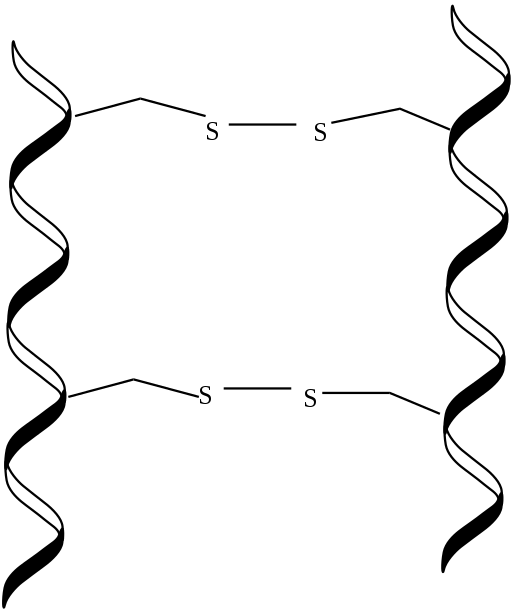Mlpatton, Keratin creation red, CC BY-SA 4.0
If you're interested in how hair bond repairants like Olaplex and Fibreplex really work, but know nothing about the make up of human hair, I suggest you first check out Lesson 3: Proteins in the Hair School. If you just need a little reminder, however, following is a short recap. If you just want to know the answer to the question "Does Olaplex Really Work?", you can skim through this post to get a quick answer.
Hair Protein Recap
Hair is made of protein, called alpha-keratin. Keratin in turn, is made of amino acids. Keratin has the shape of a helix. The amino acids bond several keratin helices together vertically and horizontally in disulfide bonds. When these bonds break, you experience damaged hair. The bonds can break through wear and tear, dyeing, heat styling, among other things.
How Hair Bond Repairants work
Olaplex and other hair bond repairants purport to mend these disulfide bonds. This is what Olaplex has to say about how their product works:
Olaplex is a bond multiplier containing a single active ingredient, Bis-Aminopropyl Diglycol Dimaleate. Olaplex works by finding single sulfur hydrogen bonds and cross linking them back together to form disulfide bonds before, during and after services. Disulfide bonds are broken via chemical, thermal, and mechanical processes. Bonds break when exposed to chemicals in colour, from heat, and mechanical force such as combing wet hair.
(SOURCE: Olaplex.com.au 2017-08-05)Essentially, you can use Olaplex before doing something damaging to your hair, to fix damage that was already there. You can mix Olaplex into your damaging treatment (such as bleach) so that it immediately mends the bonds that are broken during the treatment. And you can again use it after your treatment/heat styling/etc. to mend damage already done.
Schwarzkopf's Fibreplex similarly claims to mend broken bonds:
- N°1 Bond Booster – Protects the hair from damage during the colouration process. It interlinks with the hair fibres to enforce strong structural bonds
- Shampoo – Cleanses and restores the hair, creates bonds within the hair fibre and balances the pH level to lock in colour pigments. Provides intensive care, making the hair strong, supple and full of shine
- N°2 Bond Sealer – Creates new bonds within the hair fibre and seals the outer hair surface for noticable strength, suppleness and shine. Balances pH level to perfectly lock in colour pigments for long-lasting colour protection
- N°3 Bond Maintainer – Helps maintain the significantly improved hair quality, creates bonds within the hair fibre and balances the pH level to perfectly lock in colour pigments. Provides intensive care, making the hair strong, supple and full of shine. Protects against new mechanical damage at home
(SOURCE: Schwarzkopf-professional.co.uk 2017-08-05)
The issue here is that there is no independent research published on the subject. Generally, in the scientific community research done and sponsored by a company that stands to gain money from a positive result is seen as more unreliable than independent researchers. Still, according to Michelle at Lab Muffin, the researcher behind Olaplex seems reputable despite not being independent in the matter of Olaplex, and apparently the research also seems solid in theory (I wouldn't know personally, since I know very little about chemistry).
Does it really work?!
So the theory behind Olaxplex, at least seems pretty good, and there are plenty of positive anecdotal stories and reviews floating around, but there are no legit scientific tests done on Olaplex. A few people anecdotally got bad results as well, but considering how different hair of different people can react, I'm not surprised. I haven't found any sources on the science behind other brands of hair bond repairants, unfortunately. The active ingredient in Fibreplex is different than in Olaplex, since Olaplex holds a patent on Bis-Aminopropyl Diglycol Dimaleate. Fibreplex seems to use Maleic acid instead, if I understand correctly. Over at the SalonGeek forum, I happened upon an interesting discussion:
Maleiv acid, along with guar gum, are part of the precursors or ingredients used to manufacture Bis-Aminopropyl Diglycol Dimaleate. There is obviously a big difference in Bis-Aminopropyl Diglycol Dimaleate and maleic acid.
(SOURCE: SalonGeek.com 2017-08-05)They were pointing out the big difference in regards of patents and patent breeches. However, that does make me wonder if maleic acid is less effective than Bis-Aminopropyl Diglycol Dimaleate since why, otherwise, would Olaplex go through the trouble to manufacture Bis-Aminopropyl Diglycol Dimaleate if they could just use maleic acid? Fibreplex also includes a lot of added protein (the type that washes out) and silicones for slip, which may give the appearance of healthier hair. All in all, I don't think that the good theory behind Olaplex can be transferred to other brands that don't use Bis-Aminopropyl Diglycol Dimaleate.
So does Olaplex work? There's no proof, but it looks pretty promising and it probably doesn't hurt to try (if you can afford it!)


No comments:
Post a Comment